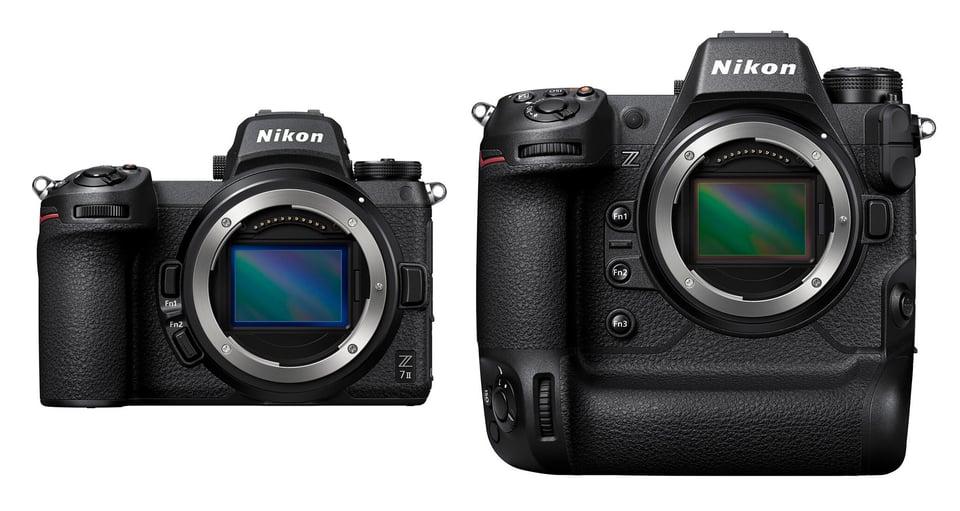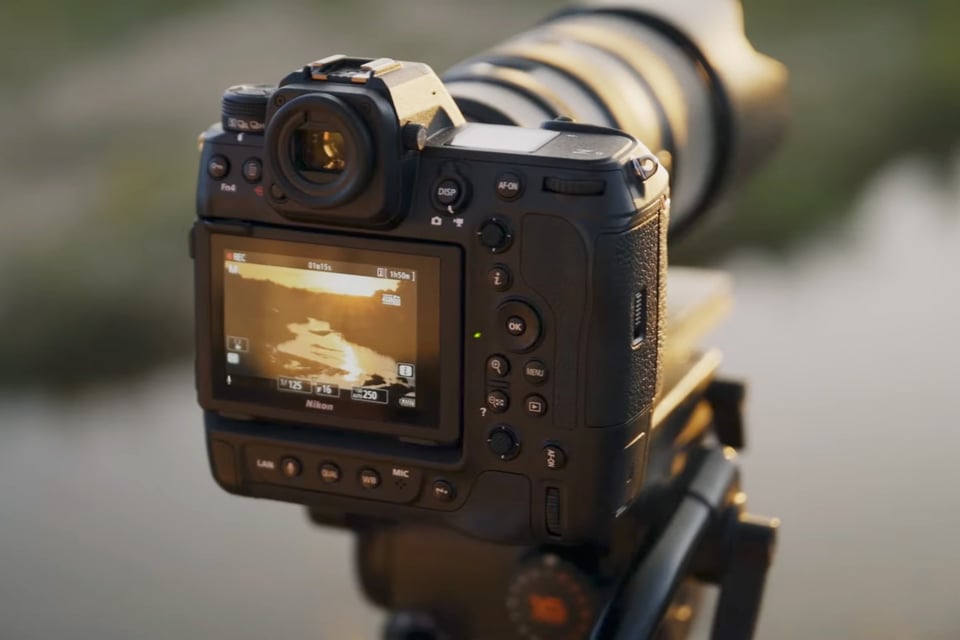The Nikon Z9 is an extremely advanced camera that overshadows most of Nikon’s previous mirrorless bodies. Even so, the Nikon Z7 II is no slouch at all – especially in its wheelhouse of landscape and travel photography. Between the Nikon Z7 II and Nikon Z9, which one is right for you? These two cameras differ in a lot of ways, but they share some key specifications behind the scenes. Let’s look at them side-by-side to help answer that question.

Specifications of Nikon Z7 II and Z9
| Camera Feature | Nikon Z7 II | Nikon Z9 |
|---|---|---|
| Announced | October 14, 2020 | October 28, 2021 |
| Sensor Resolution | 45.7 MP | 45.7 MP |
| Sensor Type | BSI CMOS | Stacked BSI CMOS |
| Sensor Size | 35.9 × 23.9mm | 35.9 × 23.9mm |
| Mount | Nikon Z | Nikon Z |
| Low-Pass Filter | No | No |
| Sensor Pixel Size | 4.35µ | 4.35µ |
| Image Size | 8256 × 5504 | 8256 × 5504 |
| In-Body Image Stabilization | Yes | Yes |
| Image Processor | Dual EXPEED 6 | EXPEED 7 |
| Continuous Shooting Speed | 9 FPS (14-Bit raw); 10 FPS (12-Bit raw) | 20 FPS (No limitations); 30 FPS (Full resolution JPEG); 120 FPS (11 Megapixel JPEG) |
| Buffer | 49 (14-Bit lossless compressed raw); 77 (12-Bit lossless compressed raw); 200 (JPEG fine, large) | 79 (14-Bit lossless compressed raw); 685 (High efficiency star raw); 1000+ (High efficiency raw); 1000+ (JPEG fine, large) |
| Native ISO Sensitivity | ISO 64-25,600 | 64-25,600 |
| Boosted Low ISO Sensitivity | ISO 32 | ISO 32 |
| Boosted High ISO Sensitivity | ISO 102,400 | ISO 102,400 |
| Dust Reduction / Sensor Cleaning | Yes | Yes |
| Sensor Dust Cover at Shutdown | Not built in | Yes |
| Shutter Types | Mechanical, Electronic, EFCS | Electronic Only |
| Viewfinder Type | Electronic Viewfinder / EVF | Electronic Viewfinder / EVF |
| Viewfinder Coverage and Magnification | 100%, 0.8× | 100%, 0.8× |
| Viewfinder Resolution | 3,690,000 dot | 3,690,000 dot |
| Built-in Flash | No | No |
| Storage Media | 1× CFe (Type B) with XQD compatibility; 1× SD UHS II | 2× CFe (Type B) with XQD Compatibility |
| Fastest Shutter Speed | 1/8000 sec | 1/32,000 sec |
| Longest Shutter Speed | 900 sec | 900 sec |
| Flash Sync Speed (Non-High-Speed) | 1/200 | 1/200 |
| Exposure Metering Sensor | TTL exposure metering using main image sensor | TTL exposure metering using main image sensor |
| Autofocus System | Hybrid PDAF; 493 AF points | Hybrid PDAF; 493 AF points |
| AF Detection Range (f/2 Standardized) | -3 to +17 EV (Down to -4 EV with low-light AF) | -5 to +20.5 EV (Down to -7 EV with starlight view) |
| Eye-Tracking AF | Yes | Yes |
| Subject Detection AF | Yes, three subjects (people, dogs, cats) | Yes, nine subjects (people, dogs, cats, birds, cars, motorcycles, trains, planes, bicycles) |
| 3D Tracking AF Mode | No | Yes |
| Focus Peaking | Yes | Yes |
| Video Maximum Resolution | 4K up to 60 FPS, 1080p up to 120 FPS | 8K up to 30p (up to 60p with future firmware update) |
| Video Compression | 4:2:2 (10-bit if over HDMI); MPEG-4/H.264 | Apple ProRes 4:2:2 HQ (10 bit internal), H.265/HEVC (8 bit /10 bit internal), H.264/AVC (8 bit) |
| Log Recording | N-log | N-log |
| Audio Recording Options | Built-in stereo microphone; External stereo microphone (optional) | Built-in stereo microphone; External stereo microphone (optional) |
| Headphone Jack | Yes | Yes |
| LCD Size and Type | 3.2″ Tilting Touchscreen | 3.2″ Dual-Axis Tilting Touchscreen |
| LCD Resolution | 2,100,000 dots | 2,100,000 dots |
| Built-in GPS | No | Yes |
| Wi-Fi | Yes | Yes |
| Bluetooth | Yes | Yes |
| Battery Life, Stills | 360 shots (CIPA); 420 shots (rear LCD only); 440 shots (rear LCD only, energy saver on) | 700 shots (CIPA); 740 shots (rear LCD only); 770 shots (rear LCD only, energy saver on) |
| Battery Life, Movies | 105 minutes (rear LCD); 100 minutes (EVF) | 170 minutes (rear LCD); 170 minutes (EVF) |
| Button Illumination | No | Yes |
| Weather Sealed Body | Yes | Yes |
| USB Version | 3.1 (Type C) | 3.1 (Type C) |
| Weight (with Battery and Card) | 705 g (1.55 lbs) | 1340 g (2.95 lbs) |
| Dimensions | 134 × 101 × 70 mm (5.3 × 4.0 × 2.8 inches) | 149 × 149.5 × 90.5 mm (5.9 × 5.9 × 3.6 inches) |
| Price Upon Introduction | $3000 | $5500 |
| Price Today | $3000 (check price) | $5500 (check price) |
Which Camera Should You Get?
Anyone who’s heard of these two cameras probably knew what the results were going to be ahead of time: The Z9 is clearly more advanced than the Z7 II. This is especially true in how quickly the Z9 can push data through the imaging pipeline, with more than double the raw FPS, a drastically larger buffer, and 8K raw video rather than 4K video.

Although the Nikon Z7 II is only ahead of the Z9 in size and weight (and some photographers may even disagree with that, preferring the Z9’s bigger grip and heft), that doesn’t make the Z7 II a bad camera. For one thing, it’s $2500 less expensive than the Z9 – money that can go directly to getting better lenses to maximize the quality of this 45-megapixel sensor. On top of that, even though the Z7 II doesn’t beat the Z9 in a lot of categories, it does tie it in some important areas, especially regarding the image sensor.
Specifically, the Z7 II and Z9 sensors both have a 45-megapixel resolution, a base ISO of 64, and a high ISO of 25,600. The biggest difference is that the Z9 has a stacked sensor, while the Z7 II does not. The purpose of a stacked sensor is to improve readout speed, which helps with the Z9’s fast frame rate. But in terms of image quality, it doesn’t offer an advantage, and the two cameras have effectively the same image quality.

For this reason, I consider the Z7 II to be almost as good of a landscape photography camera as the Z9. The lighter weight and smaller size make it easier to bring into the backcountry, although it misses out on a couple nice features like the dual-axis tilting LCD (useful for vertical compositions from a tripod) and illuminated buttons. Factoring in the Z9’s better low-light autofocus system and longer battery life, I think the Z9 beats the Z7 II in landscape situations head-to-head, but only ignoring price. I’d certainly rather shoot the Z7 II with a killer landscape lens like the Nikon Z 14-24mm f/2.8 S than the Z9 with cheaper glass.
For faster-moving genres, the comparison isn’t as close. If you need a high frame rate, big buffer, or cutting-edge autofocus system, the Z9 is clearly ahead. It’s not as though the Z7 II is terrible in any of these areas, but the Z9 is on another level. To shoot 20 FPS bursts of 45-megapixel raw photos with a 1000+ image buffer and no other limitations is really remarkable.

Copyright Libor Vaicenbacher
Frankly, the Z9 is a clear enough upgrade over the Z7 II that unless you’re a dedicated weight-minimalizer, the decision will simply come down to price. If you’re willing to spend $5500 on a camera, get the Z9. It’s the better camera in almost every way and is priced fairly for what you get. But if $5500 is a bridge too far, get the Z7 II, which is also priced fairly for its features. (If $3000 for the Z7 II is also too far, the original Nikon Z6 and Z7 are still amazing cameras and are selling for criminally low prices on the used market.)




